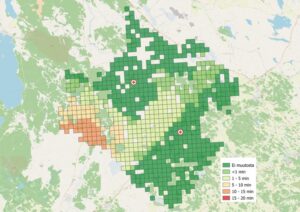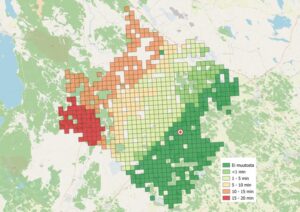Network development and analysis

One of the key questions in developing and planning operations in the long term is the organization’s location network.
Any strategic decision-making concerning the location network and the supply chain are challenging as the decisions have a long-lasting, complex impact on the company’s internal activities and its ability to create value for its end customers. The different stages of the value chain and the cost and service level factors influencing them must always be considered in any decisions concerning the network. Delfoi’s experience of operations analysis and development also covers the analysis and modeling of location networks and supply chains.
Usually, the goal of the analysis is to answer the following key questions:
- Which type of network would best enable the achievement of the strategic goals in the long term?
- What types of operational and financial impact can be achieved through changes in the network?
- What is the lifecycle cost of the different options and how well do they support the achievement of the responsibility and sustainability goals?
The long-term planning of the location network can be launched by situations such as the deployment of new operations model or concepts, changes in corporate social responsibility targets, the need to reduce the carbon footprint of operations, a cost efficiency program, predicted changes in the demand for services or products, the need to renew the facilities or, for example, changes in customs clearance or taxation policies. In the event of an acquisition, it is important to evaluate how the operations will be organized and where they will be located. An organization producing consumer products or services might aim to produce more services for the customers in the electronic channels, which often requires changes to the network as well. The supply chains of capital goods manufacturing are often long, which is why the development of the network focuses on logistics, local partners and the geographic location of the customers.

Customer accessibility, the efficiency of the activities, the costs of facilities and employee availability are increasingly emphasized in the networks of public, social welfare and healthcare services. Rapidly changing operational environment requires a new type of systematic approach to network decisions. While there is increasing need for public services, the municipalities and the regions all across Finland face budget limitations. There is also a growing need to reduce energy consumption and carbon footprint of the network. This requires operational development and could also mean more extensive use of jointly owned facilities instead of own facilities.
Instead of only minimizing the costs of facilities, the development of the network should focus on the overall cost efficiency and service ability of the operations as well as the long-term impact, such as the lifecycle costs and the carbon footprint.
At its worst, wrong network decisions can lock the facilities in suboptimal locations for decades, prevent operational development and repel customers.
Optimal preparations, in turn, can help develop the network in the long term in a direction that is in line with strategic goals. Ideally, the preparations before decisions also include careful comparison of alternative scenarios and evaluating operational and financial impact.


Implementation of the location network analysis
A working plan is prepared for each network analysis according to the goals, allowing the work to be carried out in a high-quality, efficient way. As an independent external expert, we will ensure that the analysis includes the essential assessment areas and that the options are evaluated impartially by means of verified current-state facts, future modeling, and simulations.
The network analysis usually consists of the usual main steps:
- defining the goals
- description of the current state, data collection and analysis
- defining alternative scenarios
- modeling and comparing the scenarios
- conclusions and reporting.
When defining the goals, we can specify the largest allowed changes in the costs of the facilities, operational costs, accessibility or travel time. A target-oriented maximum investment budget can also be set for the network for the period under review.
When describing the current state and defining the scenarios, the participation of the customer’s executives and experts in the form of workshops, site visits and process description work, among other things, is emphasized. Optimization can be used in the development of the scenarios and optimal, so-called clean slate options from the perspective of transport efficiency, customer accessibility or spatial efficiency, for example, can be created as a point of reference for the current state. This produces data on the impact of different variables and helps develop improved versions of the current status scenario with various emphases.
The analyses are implemented with the state-of-the-art methods at our disposal, utilizing elements such as geographic information system, simulation, optimization, and surveys directed at stakeholders and customers. Previous planning information and more detailed materials from both public sources and the customer’s core operation information systems are used in the data collection. If necessary, the data is supplemented with measurements and observations. More detailed information on the operations of the production and logistics facilities can be produced with more precise, facility-specific simulation models.
Simulation model for the order-delivery chain
Simulation is an affordable, fast and safe way to examine the functions and key figures of the logistics chain as well as facilities and systems. Computer simulation means temporally imitating the impact of the existing or planned system. One of the benefits of a discrete-event simulation is that the essential details can be taken into account in the analysis of logistics systems with sufficient precision. The combined impact of interdependent events, logistics control methods and parameters can be considered when using simulation to predict the result of the modeled system.
For example, simulation can be used to coordinate the schedules of the incoming or outgoing deliveries of a plant and the capacity in different times of the day. In simulation, it is easy to make changes to the logistics processes, the production control of the delivery chain and the equipment capacity, whereupon the impact of individual changes can be observed throughout the delivery chain. Existing initial information on, for example, the ERP system, route planning, inventory management system and method and process descriptions can be used in the simulation model.
The simulation model produces key figures for comparing different scenarios. In addition to numerical simulation, event updates can be followed visually as a 3D animation, making it easier and faster to interpret the results. The same model can be understood by the employees, the marketing department and the operative management.
Simulation can be used to analyze the resources needed for the production of services and products in different branches (facilities, equipment, personnel) in detail. For example, the potential scaling benefits of a larger production unit size can be verified using facts. Experts of real estate costs and statistics specialists, provided by the customer or the partner network of Delfoi, can use the modeled facility figures to specify the rental costs of new premises, premises in need of slight renovations or premises in need of extensive alteration, for example.
Use of Geographic Information Systems (GIS)
Geospatial analytics play a key role in the overall optimization of the network. It can be used to model the accessibility of the branches for different customer segments in comparable scenarios, among other things. Geospatial analytics can also be used to model the changes to the transport of customers or to customers’ independent movement if the number of branches is reduced and some of them are relocated. A completely new network option, optimized according to the chosen parameters, can also be created with the clean slate tactic as a point of reference using analytics. Geospatial analytics can also be used for modeling transport times, routes and distances and for calculating transport and logistics costs. The availability of personnel or the distance to partners can also be calculated in a precise manner using analytics.
The results and conclusions are summarized in a visual format and any detailed assumptions and analyses are documented transparently in a format useful to the customer.



